Analyzing the Impact of Closing the Gap Policy on Health Outcomes
VerifiedAdded on 2022/09/15
|9
|2569
|12
Essay
AI Summary
This essay analyzes the Closing the Gap (CTG) policy, a significant government strategy implemented in Australia to address health inequalities among Aboriginal and Torres Strait Islander peoples. The paper begins by outlining the policy's history, including the social justice report and the Close the Gap campaign, and the data that influenced its creation. It then examines the policy's impact on various health outcomes, such as life expectancy, child mortality, and access to education and healthcare, while acknowledging the challenges and barriers to achieving its goals. The essay uses a case study of Judy, a 57-year-old Aboriginal woman with type 2 diabetes, to illustrate the policy's impact on individual health and well-being. It analyzes how Judy's condition is affected by her lack of income, social support, and access to healthcare, and how the CTG policy addresses these issues. The roles of Aboriginal Medical Services (AMS) and Aboriginal Liaison Officers (ALO) are defined, highlighting their importance in providing culturally sensitive healthcare and support. The essay concludes by summarizing the benefits of CTG policy registration and the importance of the AMS and ALO in improving health outcomes for Indigenous Australians. The essay draws upon relevant literature and statistics to support its analysis.
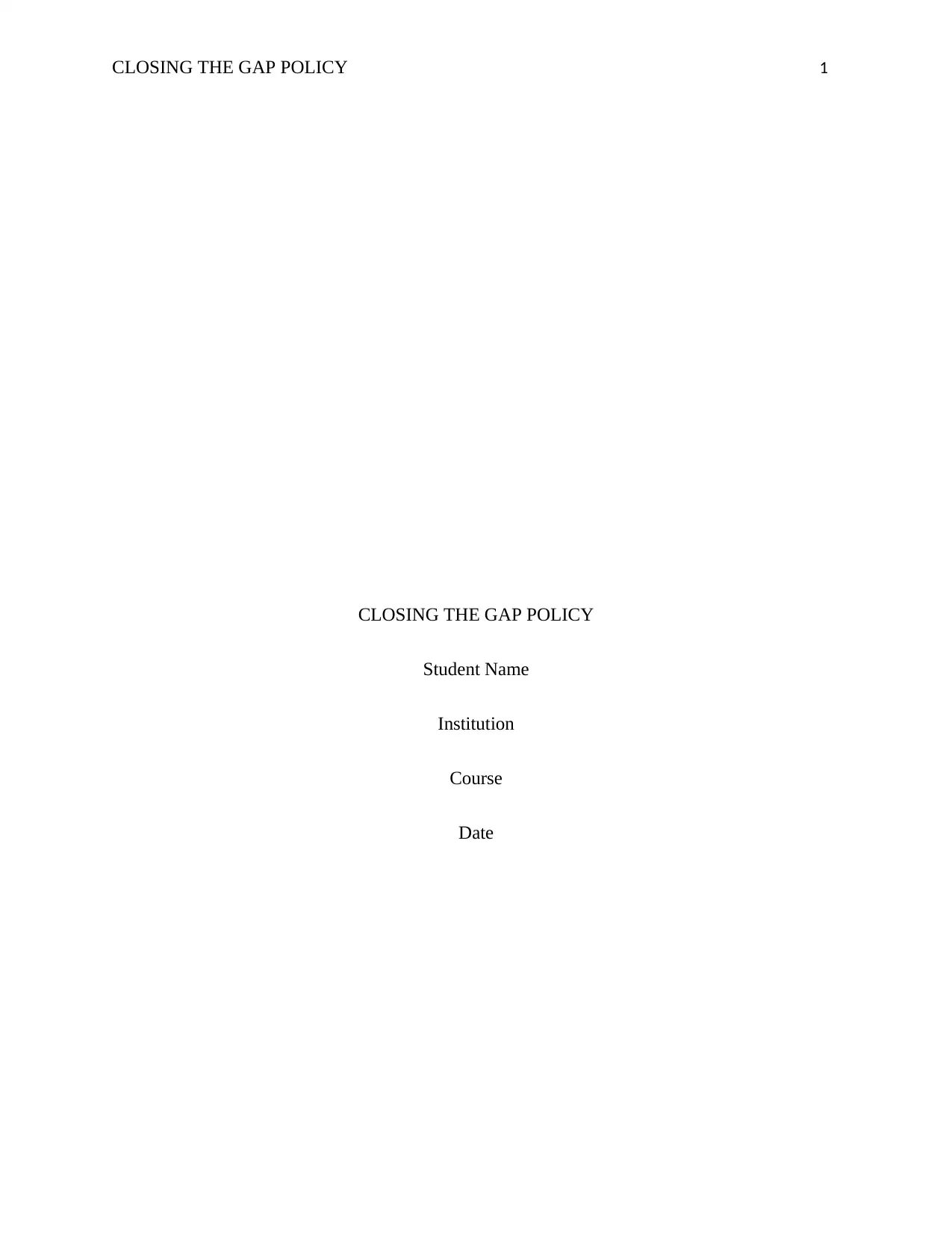
CLOSING THE GAP POLICY 1
CLOSING THE GAP POLICY
Student Name
Institution
Course
Date
CLOSING THE GAP POLICY
Student Name
Institution
Course
Date
Paraphrase This Document
Need a fresh take? Get an instant paraphrase of this document with our AI Paraphraser
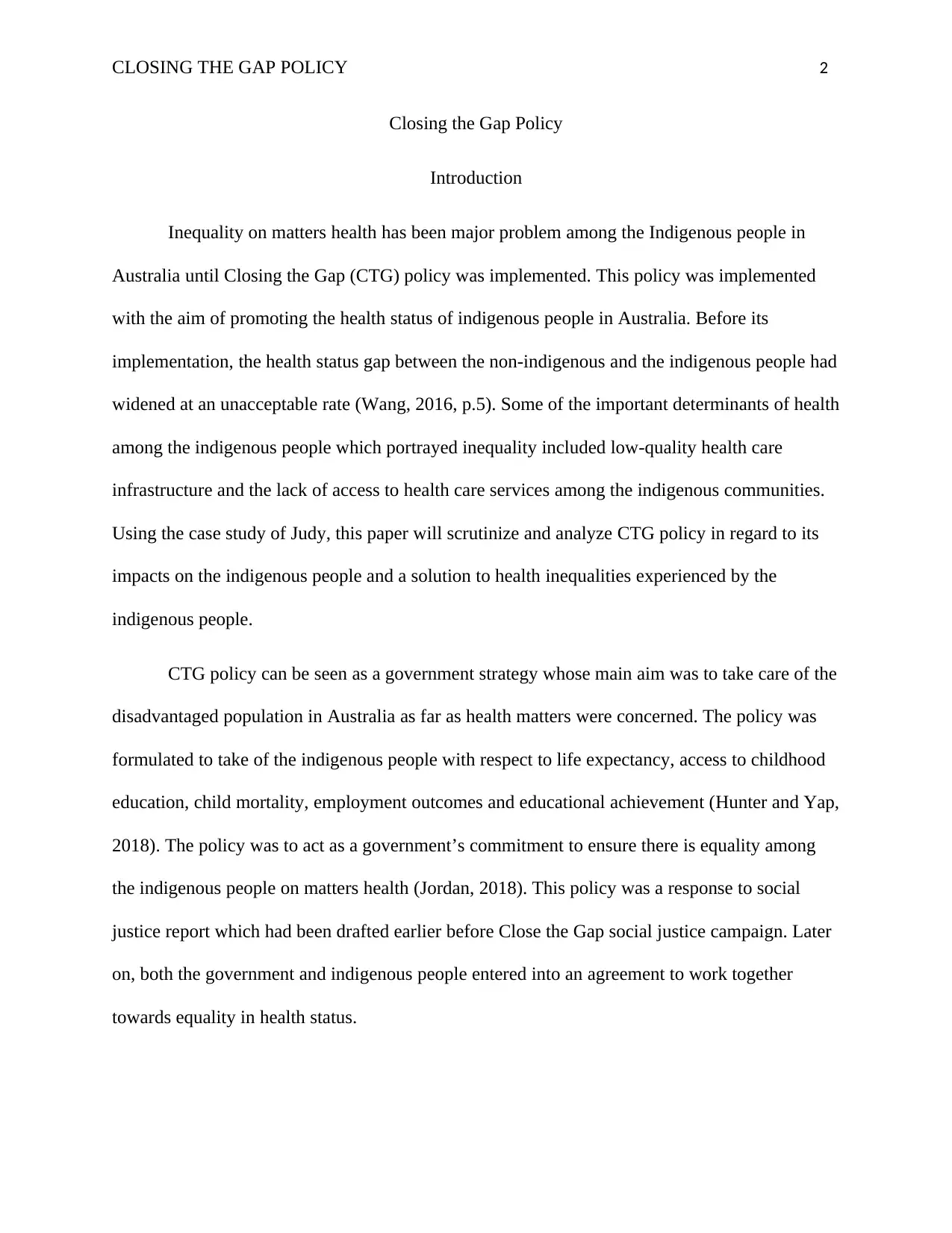
CLOSING THE GAP POLICY 2
Closing the Gap Policy
Introduction
Inequality on matters health has been major problem among the Indigenous people in
Australia until Closing the Gap (CTG) policy was implemented. This policy was implemented
with the aim of promoting the health status of indigenous people in Australia. Before its
implementation, the health status gap between the non-indigenous and the indigenous people had
widened at an unacceptable rate (Wang, 2016, p.5). Some of the important determinants of health
among the indigenous people which portrayed inequality included low-quality health care
infrastructure and the lack of access to health care services among the indigenous communities.
Using the case study of Judy, this paper will scrutinize and analyze CTG policy in regard to its
impacts on the indigenous people and a solution to health inequalities experienced by the
indigenous people.
CTG policy can be seen as a government strategy whose main aim was to take care of the
disadvantaged population in Australia as far as health matters were concerned. The policy was
formulated to take of the indigenous people with respect to life expectancy, access to childhood
education, child mortality, employment outcomes and educational achievement (Hunter and Yap,
2018). The policy was to act as a government’s commitment to ensure there is equality among
the indigenous people on matters health (Jordan, 2018). This policy was a response to social
justice report which had been drafted earlier before Close the Gap social justice campaign. Later
on, both the government and indigenous people entered into an agreement to work together
towards equality in health status.
Closing the Gap Policy
Introduction
Inequality on matters health has been major problem among the Indigenous people in
Australia until Closing the Gap (CTG) policy was implemented. This policy was implemented
with the aim of promoting the health status of indigenous people in Australia. Before its
implementation, the health status gap between the non-indigenous and the indigenous people had
widened at an unacceptable rate (Wang, 2016, p.5). Some of the important determinants of health
among the indigenous people which portrayed inequality included low-quality health care
infrastructure and the lack of access to health care services among the indigenous communities.
Using the case study of Judy, this paper will scrutinize and analyze CTG policy in regard to its
impacts on the indigenous people and a solution to health inequalities experienced by the
indigenous people.
CTG policy can be seen as a government strategy whose main aim was to take care of the
disadvantaged population in Australia as far as health matters were concerned. The policy was
formulated to take of the indigenous people with respect to life expectancy, access to childhood
education, child mortality, employment outcomes and educational achievement (Hunter and Yap,
2018). The policy was to act as a government’s commitment to ensure there is equality among
the indigenous people on matters health (Jordan, 2018). This policy was a response to social
justice report which had been drafted earlier before Close the Gap social justice campaign. Later
on, both the government and indigenous people entered into an agreement to work together
towards equality in health status.
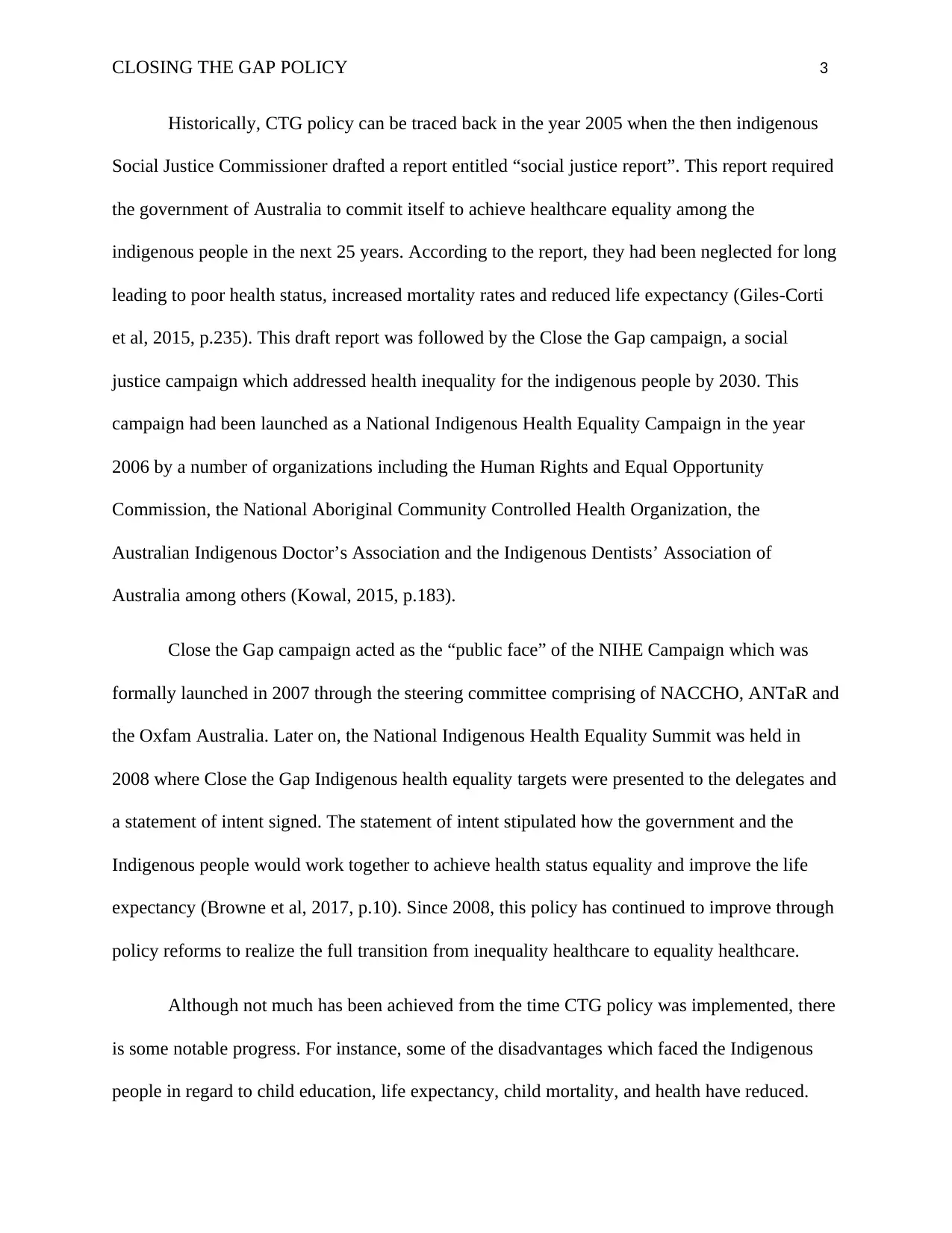
CLOSING THE GAP POLICY 3
Historically, CTG policy can be traced back in the year 2005 when the then indigenous
Social Justice Commissioner drafted a report entitled “social justice report”. This report required
the government of Australia to commit itself to achieve healthcare equality among the
indigenous people in the next 25 years. According to the report, they had been neglected for long
leading to poor health status, increased mortality rates and reduced life expectancy (Giles-Corti
et al, 2015, p.235). This draft report was followed by the Close the Gap campaign, a social
justice campaign which addressed health inequality for the indigenous people by 2030. This
campaign had been launched as a National Indigenous Health Equality Campaign in the year
2006 by a number of organizations including the Human Rights and Equal Opportunity
Commission, the National Aboriginal Community Controlled Health Organization, the
Australian Indigenous Doctor’s Association and the Indigenous Dentists’ Association of
Australia among others (Kowal, 2015, p.183).
Close the Gap campaign acted as the “public face” of the NIHE Campaign which was
formally launched in 2007 through the steering committee comprising of NACCHO, ANTaR and
the Oxfam Australia. Later on, the National Indigenous Health Equality Summit was held in
2008 where Close the Gap Indigenous health equality targets were presented to the delegates and
a statement of intent signed. The statement of intent stipulated how the government and the
Indigenous people would work together to achieve health status equality and improve the life
expectancy (Browne et al, 2017, p.10). Since 2008, this policy has continued to improve through
policy reforms to realize the full transition from inequality healthcare to equality healthcare.
Although not much has been achieved from the time CTG policy was implemented, there
is some notable progress. For instance, some of the disadvantages which faced the Indigenous
people in regard to child education, life expectancy, child mortality, and health have reduced.
Historically, CTG policy can be traced back in the year 2005 when the then indigenous
Social Justice Commissioner drafted a report entitled “social justice report”. This report required
the government of Australia to commit itself to achieve healthcare equality among the
indigenous people in the next 25 years. According to the report, they had been neglected for long
leading to poor health status, increased mortality rates and reduced life expectancy (Giles-Corti
et al, 2015, p.235). This draft report was followed by the Close the Gap campaign, a social
justice campaign which addressed health inequality for the indigenous people by 2030. This
campaign had been launched as a National Indigenous Health Equality Campaign in the year
2006 by a number of organizations including the Human Rights and Equal Opportunity
Commission, the National Aboriginal Community Controlled Health Organization, the
Australian Indigenous Doctor’s Association and the Indigenous Dentists’ Association of
Australia among others (Kowal, 2015, p.183).
Close the Gap campaign acted as the “public face” of the NIHE Campaign which was
formally launched in 2007 through the steering committee comprising of NACCHO, ANTaR and
the Oxfam Australia. Later on, the National Indigenous Health Equality Summit was held in
2008 where Close the Gap Indigenous health equality targets were presented to the delegates and
a statement of intent signed. The statement of intent stipulated how the government and the
Indigenous people would work together to achieve health status equality and improve the life
expectancy (Browne et al, 2017, p.10). Since 2008, this policy has continued to improve through
policy reforms to realize the full transition from inequality healthcare to equality healthcare.
Although not much has been achieved from the time CTG policy was implemented, there
is some notable progress. For instance, some of the disadvantages which faced the Indigenous
people in regard to child education, life expectancy, child mortality, and health have reduced.
⊘ This is a preview!⊘
Do you want full access?
Subscribe today to unlock all pages.

Trusted by 1+ million students worldwide
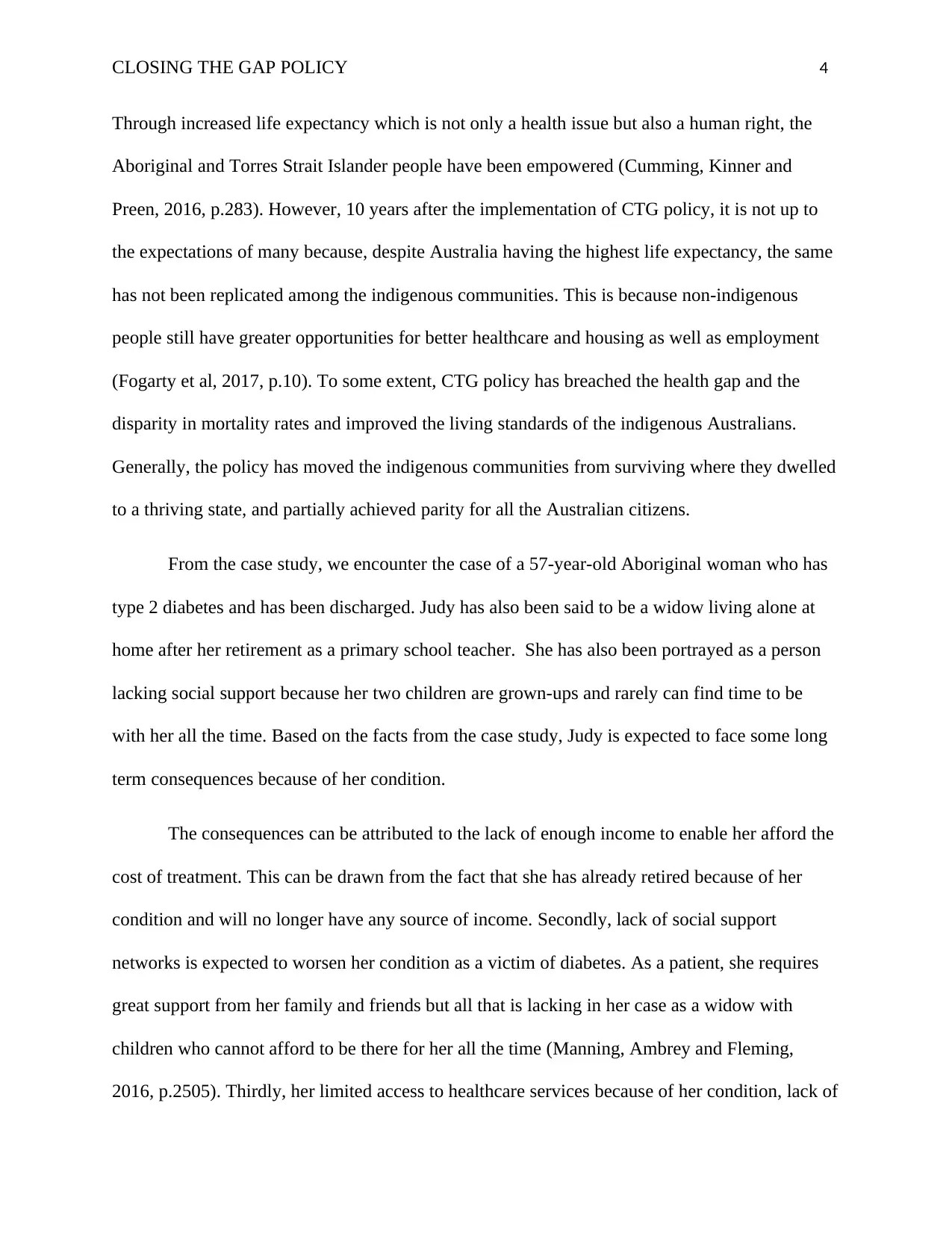
CLOSING THE GAP POLICY 4
Through increased life expectancy which is not only a health issue but also a human right, the
Aboriginal and Torres Strait Islander people have been empowered (Cumming, Kinner and
Preen, 2016, p.283). However, 10 years after the implementation of CTG policy, it is not up to
the expectations of many because, despite Australia having the highest life expectancy, the same
has not been replicated among the indigenous communities. This is because non-indigenous
people still have greater opportunities for better healthcare and housing as well as employment
(Fogarty et al, 2017, p.10). To some extent, CTG policy has breached the health gap and the
disparity in mortality rates and improved the living standards of the indigenous Australians.
Generally, the policy has moved the indigenous communities from surviving where they dwelled
to a thriving state, and partially achieved parity for all the Australian citizens.
From the case study, we encounter the case of a 57-year-old Aboriginal woman who has
type 2 diabetes and has been discharged. Judy has also been said to be a widow living alone at
home after her retirement as a primary school teacher. She has also been portrayed as a person
lacking social support because her two children are grown-ups and rarely can find time to be
with her all the time. Based on the facts from the case study, Judy is expected to face some long
term consequences because of her condition.
The consequences can be attributed to the lack of enough income to enable her afford the
cost of treatment. This can be drawn from the fact that she has already retired because of her
condition and will no longer have any source of income. Secondly, lack of social support
networks is expected to worsen her condition as a victim of diabetes. As a patient, she requires
great support from her family and friends but all that is lacking in her case as a widow with
children who cannot afford to be there for her all the time (Manning, Ambrey and Fleming,
2016, p.2505). Thirdly, her limited access to healthcare services because of her condition, lack of
Through increased life expectancy which is not only a health issue but also a human right, the
Aboriginal and Torres Strait Islander people have been empowered (Cumming, Kinner and
Preen, 2016, p.283). However, 10 years after the implementation of CTG policy, it is not up to
the expectations of many because, despite Australia having the highest life expectancy, the same
has not been replicated among the indigenous communities. This is because non-indigenous
people still have greater opportunities for better healthcare and housing as well as employment
(Fogarty et al, 2017, p.10). To some extent, CTG policy has breached the health gap and the
disparity in mortality rates and improved the living standards of the indigenous Australians.
Generally, the policy has moved the indigenous communities from surviving where they dwelled
to a thriving state, and partially achieved parity for all the Australian citizens.
From the case study, we encounter the case of a 57-year-old Aboriginal woman who has
type 2 diabetes and has been discharged. Judy has also been said to be a widow living alone at
home after her retirement as a primary school teacher. She has also been portrayed as a person
lacking social support because her two children are grown-ups and rarely can find time to be
with her all the time. Based on the facts from the case study, Judy is expected to face some long
term consequences because of her condition.
The consequences can be attributed to the lack of enough income to enable her afford the
cost of treatment. This can be drawn from the fact that she has already retired because of her
condition and will no longer have any source of income. Secondly, lack of social support
networks is expected to worsen her condition as a victim of diabetes. As a patient, she requires
great support from her family and friends but all that is lacking in her case as a widow with
children who cannot afford to be there for her all the time (Manning, Ambrey and Fleming,
2016, p.2505). Thirdly, her limited access to healthcare services because of her condition, lack of
Paraphrase This Document
Need a fresh take? Get an instant paraphrase of this document with our AI Paraphraser
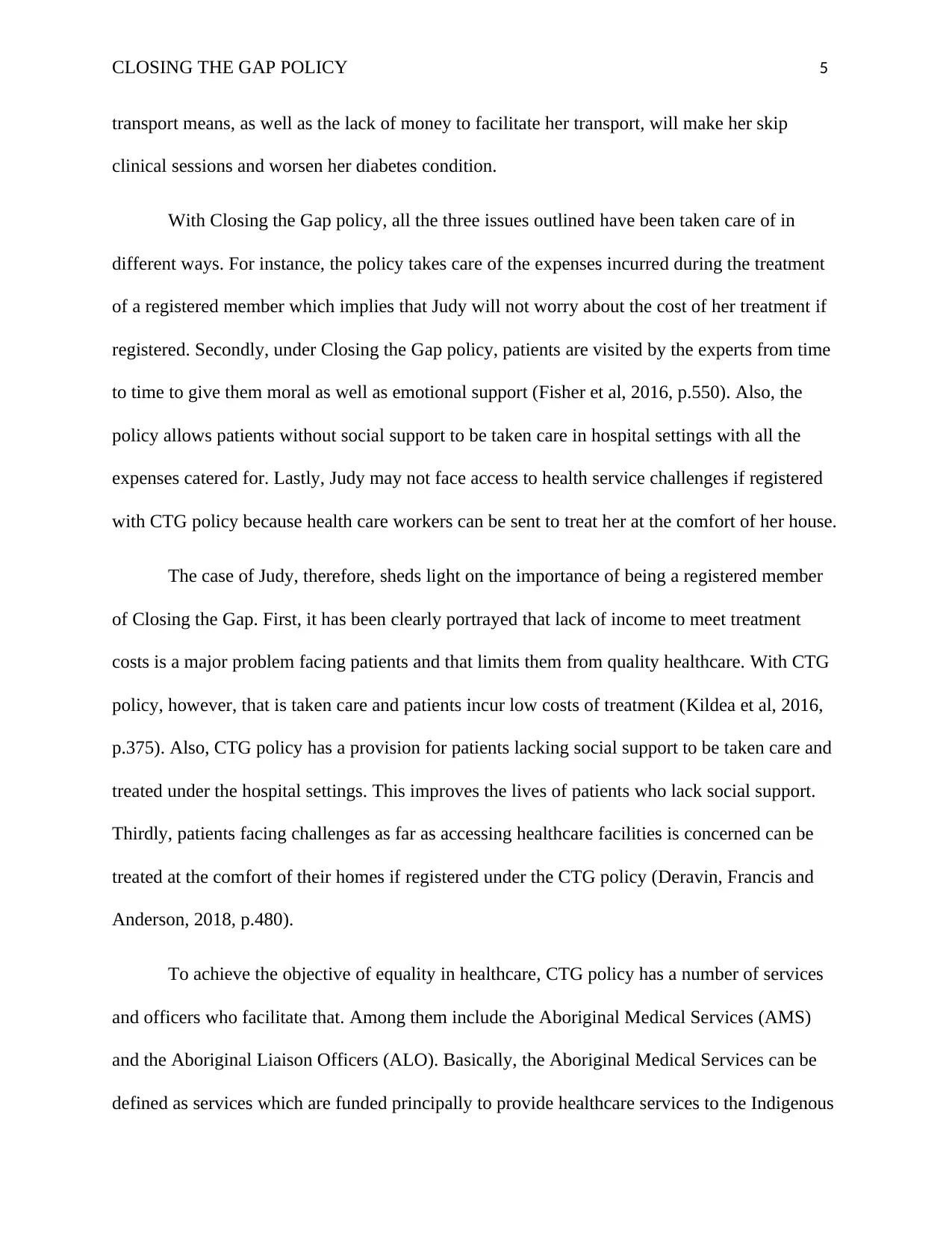
CLOSING THE GAP POLICY 5
transport means, as well as the lack of money to facilitate her transport, will make her skip
clinical sessions and worsen her diabetes condition.
With Closing the Gap policy, all the three issues outlined have been taken care of in
different ways. For instance, the policy takes care of the expenses incurred during the treatment
of a registered member which implies that Judy will not worry about the cost of her treatment if
registered. Secondly, under Closing the Gap policy, patients are visited by the experts from time
to time to give them moral as well as emotional support (Fisher et al, 2016, p.550). Also, the
policy allows patients without social support to be taken care in hospital settings with all the
expenses catered for. Lastly, Judy may not face access to health service challenges if registered
with CTG policy because health care workers can be sent to treat her at the comfort of her house.
The case of Judy, therefore, sheds light on the importance of being a registered member
of Closing the Gap. First, it has been clearly portrayed that lack of income to meet treatment
costs is a major problem facing patients and that limits them from quality healthcare. With CTG
policy, however, that is taken care and patients incur low costs of treatment (Kildea et al, 2016,
p.375). Also, CTG policy has a provision for patients lacking social support to be taken care and
treated under the hospital settings. This improves the lives of patients who lack social support.
Thirdly, patients facing challenges as far as accessing healthcare facilities is concerned can be
treated at the comfort of their homes if registered under the CTG policy (Deravin, Francis and
Anderson, 2018, p.480).
To achieve the objective of equality in healthcare, CTG policy has a number of services
and officers who facilitate that. Among them include the Aboriginal Medical Services (AMS)
and the Aboriginal Liaison Officers (ALO). Basically, the Aboriginal Medical Services can be
defined as services which are funded principally to provide healthcare services to the Indigenous
transport means, as well as the lack of money to facilitate her transport, will make her skip
clinical sessions and worsen her diabetes condition.
With Closing the Gap policy, all the three issues outlined have been taken care of in
different ways. For instance, the policy takes care of the expenses incurred during the treatment
of a registered member which implies that Judy will not worry about the cost of her treatment if
registered. Secondly, under Closing the Gap policy, patients are visited by the experts from time
to time to give them moral as well as emotional support (Fisher et al, 2016, p.550). Also, the
policy allows patients without social support to be taken care in hospital settings with all the
expenses catered for. Lastly, Judy may not face access to health service challenges if registered
with CTG policy because health care workers can be sent to treat her at the comfort of her house.
The case of Judy, therefore, sheds light on the importance of being a registered member
of Closing the Gap. First, it has been clearly portrayed that lack of income to meet treatment
costs is a major problem facing patients and that limits them from quality healthcare. With CTG
policy, however, that is taken care and patients incur low costs of treatment (Kildea et al, 2016,
p.375). Also, CTG policy has a provision for patients lacking social support to be taken care and
treated under the hospital settings. This improves the lives of patients who lack social support.
Thirdly, patients facing challenges as far as accessing healthcare facilities is concerned can be
treated at the comfort of their homes if registered under the CTG policy (Deravin, Francis and
Anderson, 2018, p.480).
To achieve the objective of equality in healthcare, CTG policy has a number of services
and officers who facilitate that. Among them include the Aboriginal Medical Services (AMS)
and the Aboriginal Liaison Officers (ALO). Basically, the Aboriginal Medical Services can be
defined as services which are funded principally to provide healthcare services to the Indigenous
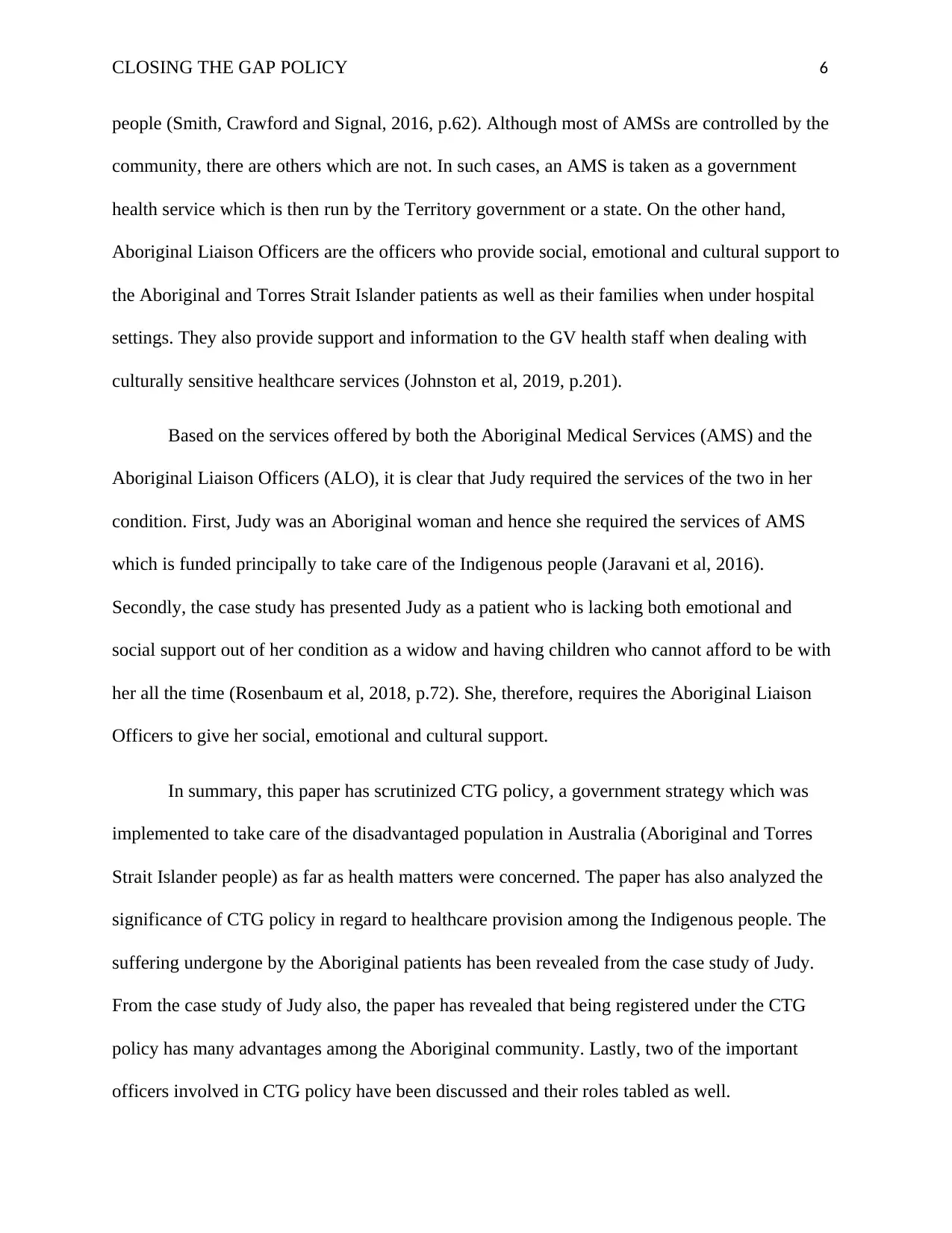
CLOSING THE GAP POLICY 6
people (Smith, Crawford and Signal, 2016, p.62). Although most of AMSs are controlled by the
community, there are others which are not. In such cases, an AMS is taken as a government
health service which is then run by the Territory government or a state. On the other hand,
Aboriginal Liaison Officers are the officers who provide social, emotional and cultural support to
the Aboriginal and Torres Strait Islander patients as well as their families when under hospital
settings. They also provide support and information to the GV health staff when dealing with
culturally sensitive healthcare services (Johnston et al, 2019, p.201).
Based on the services offered by both the Aboriginal Medical Services (AMS) and the
Aboriginal Liaison Officers (ALO), it is clear that Judy required the services of the two in her
condition. First, Judy was an Aboriginal woman and hence she required the services of AMS
which is funded principally to take care of the Indigenous people (Jaravani et al, 2016).
Secondly, the case study has presented Judy as a patient who is lacking both emotional and
social support out of her condition as a widow and having children who cannot afford to be with
her all the time (Rosenbaum et al, 2018, p.72). She, therefore, requires the Aboriginal Liaison
Officers to give her social, emotional and cultural support.
In summary, this paper has scrutinized CTG policy, a government strategy which was
implemented to take care of the disadvantaged population in Australia (Aboriginal and Torres
Strait Islander people) as far as health matters were concerned. The paper has also analyzed the
significance of CTG policy in regard to healthcare provision among the Indigenous people. The
suffering undergone by the Aboriginal patients has been revealed from the case study of Judy.
From the case study of Judy also, the paper has revealed that being registered under the CTG
policy has many advantages among the Aboriginal community. Lastly, two of the important
officers involved in CTG policy have been discussed and their roles tabled as well.
people (Smith, Crawford and Signal, 2016, p.62). Although most of AMSs are controlled by the
community, there are others which are not. In such cases, an AMS is taken as a government
health service which is then run by the Territory government or a state. On the other hand,
Aboriginal Liaison Officers are the officers who provide social, emotional and cultural support to
the Aboriginal and Torres Strait Islander patients as well as their families when under hospital
settings. They also provide support and information to the GV health staff when dealing with
culturally sensitive healthcare services (Johnston et al, 2019, p.201).
Based on the services offered by both the Aboriginal Medical Services (AMS) and the
Aboriginal Liaison Officers (ALO), it is clear that Judy required the services of the two in her
condition. First, Judy was an Aboriginal woman and hence she required the services of AMS
which is funded principally to take care of the Indigenous people (Jaravani et al, 2016).
Secondly, the case study has presented Judy as a patient who is lacking both emotional and
social support out of her condition as a widow and having children who cannot afford to be with
her all the time (Rosenbaum et al, 2018, p.72). She, therefore, requires the Aboriginal Liaison
Officers to give her social, emotional and cultural support.
In summary, this paper has scrutinized CTG policy, a government strategy which was
implemented to take care of the disadvantaged population in Australia (Aboriginal and Torres
Strait Islander people) as far as health matters were concerned. The paper has also analyzed the
significance of CTG policy in regard to healthcare provision among the Indigenous people. The
suffering undergone by the Aboriginal patients has been revealed from the case study of Judy.
From the case study of Judy also, the paper has revealed that being registered under the CTG
policy has many advantages among the Aboriginal community. Lastly, two of the important
officers involved in CTG policy have been discussed and their roles tabled as well.
⊘ This is a preview!⊘
Do you want full access?
Subscribe today to unlock all pages.

Trusted by 1+ million students worldwide
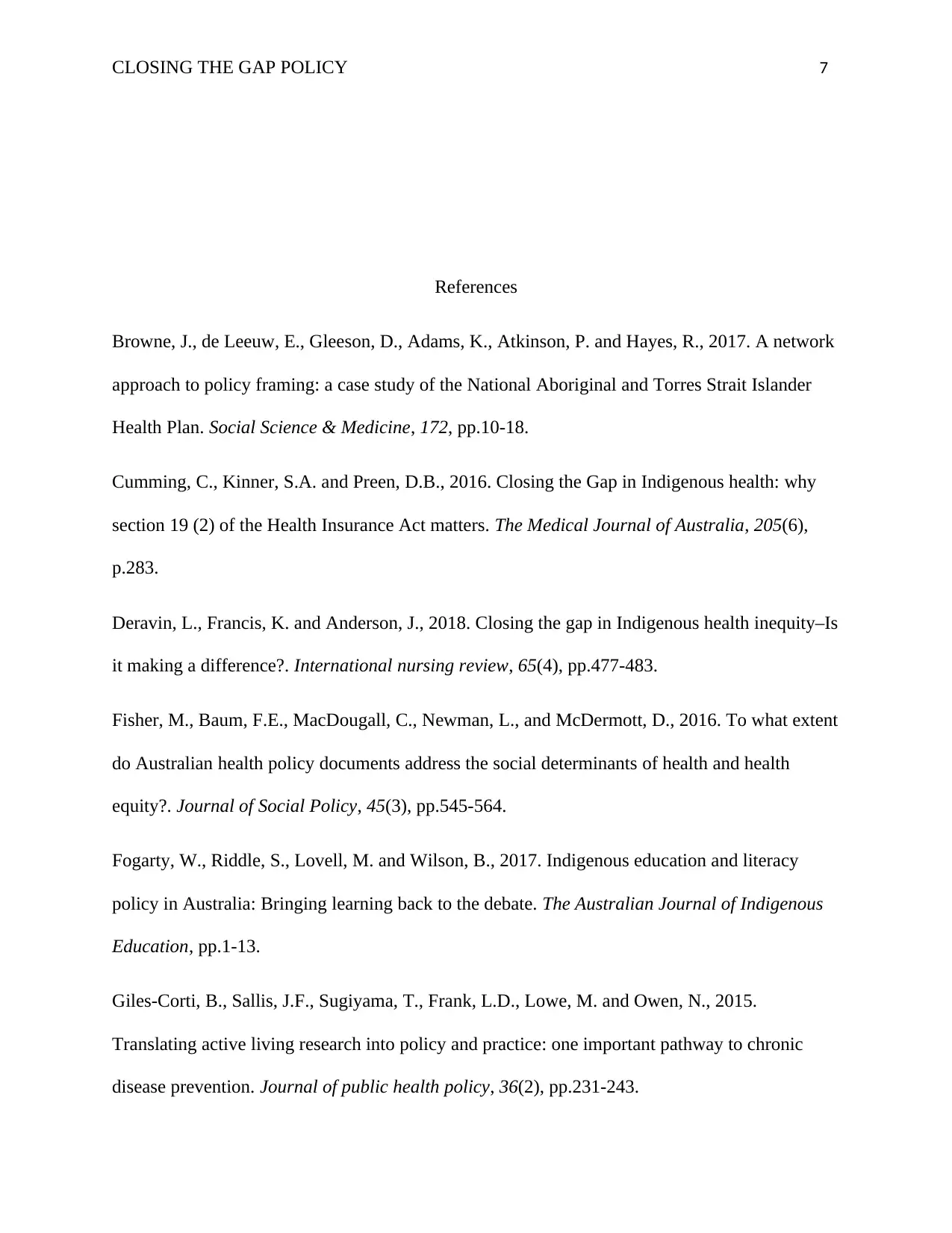
CLOSING THE GAP POLICY 7
References
Browne, J., de Leeuw, E., Gleeson, D., Adams, K., Atkinson, P. and Hayes, R., 2017. A network
approach to policy framing: a case study of the National Aboriginal and Torres Strait Islander
Health Plan. Social Science & Medicine, 172, pp.10-18.
Cumming, C., Kinner, S.A. and Preen, D.B., 2016. Closing the Gap in Indigenous health: why
section 19 (2) of the Health Insurance Act matters. The Medical Journal of Australia, 205(6),
p.283.
Deravin, L., Francis, K. and Anderson, J., 2018. Closing the gap in Indigenous health inequity–Is
it making a difference?. International nursing review, 65(4), pp.477-483.
Fisher, M., Baum, F.E., MacDougall, C., Newman, L., and McDermott, D., 2016. To what extent
do Australian health policy documents address the social determinants of health and health
equity?. Journal of Social Policy, 45(3), pp.545-564.
Fogarty, W., Riddle, S., Lovell, M. and Wilson, B., 2017. Indigenous education and literacy
policy in Australia: Bringing learning back to the debate. The Australian Journal of Indigenous
Education, pp.1-13.
Giles-Corti, B., Sallis, J.F., Sugiyama, T., Frank, L.D., Lowe, M. and Owen, N., 2015.
Translating active living research into policy and practice: one important pathway to chronic
disease prevention. Journal of public health policy, 36(2), pp.231-243.
References
Browne, J., de Leeuw, E., Gleeson, D., Adams, K., Atkinson, P. and Hayes, R., 2017. A network
approach to policy framing: a case study of the National Aboriginal and Torres Strait Islander
Health Plan. Social Science & Medicine, 172, pp.10-18.
Cumming, C., Kinner, S.A. and Preen, D.B., 2016. Closing the Gap in Indigenous health: why
section 19 (2) of the Health Insurance Act matters. The Medical Journal of Australia, 205(6),
p.283.
Deravin, L., Francis, K. and Anderson, J., 2018. Closing the gap in Indigenous health inequity–Is
it making a difference?. International nursing review, 65(4), pp.477-483.
Fisher, M., Baum, F.E., MacDougall, C., Newman, L., and McDermott, D., 2016. To what extent
do Australian health policy documents address the social determinants of health and health
equity?. Journal of Social Policy, 45(3), pp.545-564.
Fogarty, W., Riddle, S., Lovell, M. and Wilson, B., 2017. Indigenous education and literacy
policy in Australia: Bringing learning back to the debate. The Australian Journal of Indigenous
Education, pp.1-13.
Giles-Corti, B., Sallis, J.F., Sugiyama, T., Frank, L.D., Lowe, M. and Owen, N., 2015.
Translating active living research into policy and practice: one important pathway to chronic
disease prevention. Journal of public health policy, 36(2), pp.231-243.
Paraphrase This Document
Need a fresh take? Get an instant paraphrase of this document with our AI Paraphraser
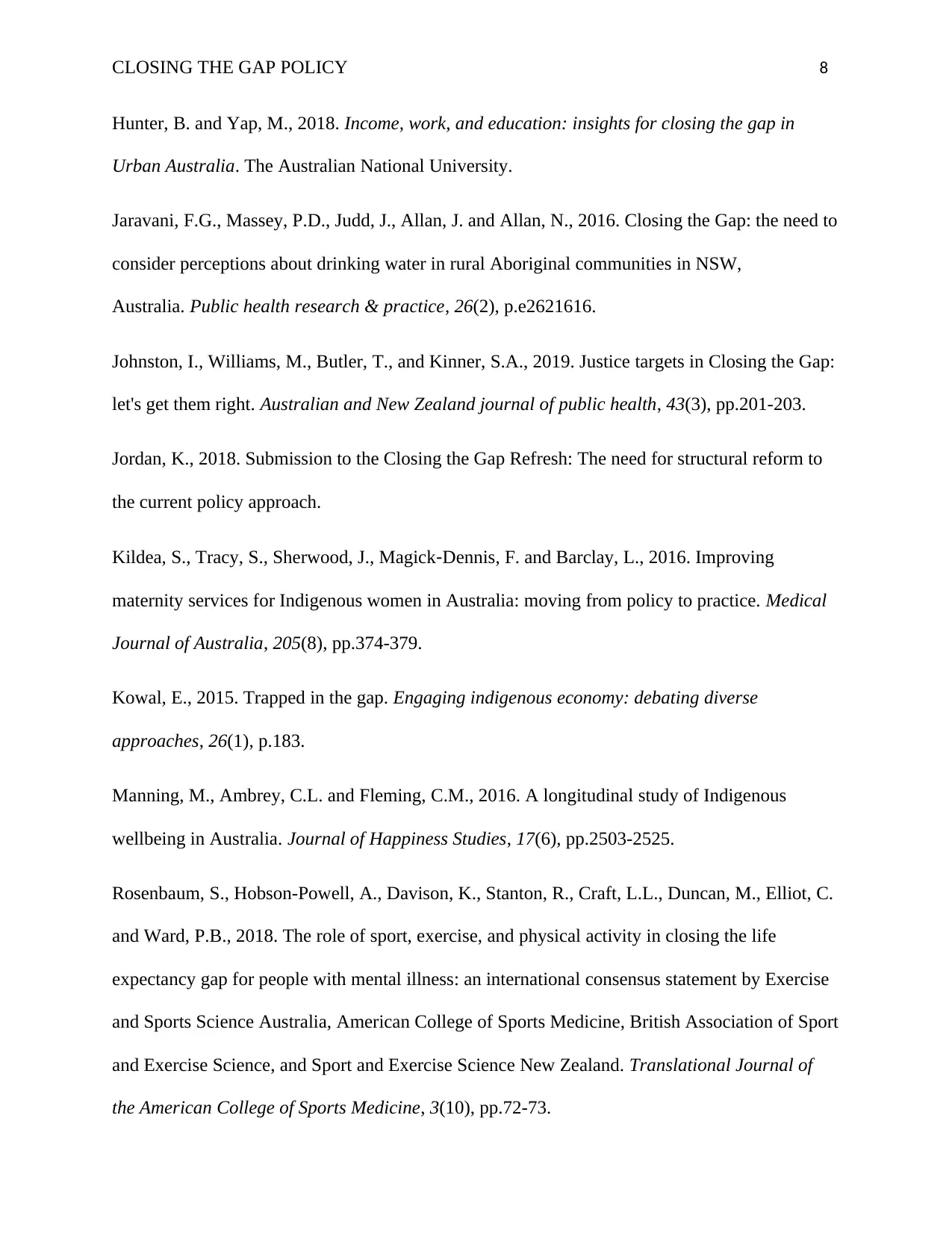
CLOSING THE GAP POLICY 8
Hunter, B. and Yap, M., 2018. Income, work, and education: insights for closing the gap in
Urban Australia. The Australian National University.
Jaravani, F.G., Massey, P.D., Judd, J., Allan, J. and Allan, N., 2016. Closing the Gap: the need to
consider perceptions about drinking water in rural Aboriginal communities in NSW,
Australia. Public health research & practice, 26(2), p.e2621616.
Johnston, I., Williams, M., Butler, T., and Kinner, S.A., 2019. Justice targets in Closing the Gap:
let's get them right. Australian and New Zealand journal of public health, 43(3), pp.201-203.
Jordan, K., 2018. Submission to the Closing the Gap Refresh: The need for structural reform to
the current policy approach.
Kildea, S., Tracy, S., Sherwood, J., Magick‐Dennis, F. and Barclay, L., 2016. Improving
maternity services for Indigenous women in Australia: moving from policy to practice. Medical
Journal of Australia, 205(8), pp.374-379.
Kowal, E., 2015. Trapped in the gap. Engaging indigenous economy: debating diverse
approaches, 26(1), p.183.
Manning, M., Ambrey, C.L. and Fleming, C.M., 2016. A longitudinal study of Indigenous
wellbeing in Australia. Journal of Happiness Studies, 17(6), pp.2503-2525.
Rosenbaum, S., Hobson-Powell, A., Davison, K., Stanton, R., Craft, L.L., Duncan, M., Elliot, C.
and Ward, P.B., 2018. The role of sport, exercise, and physical activity in closing the life
expectancy gap for people with mental illness: an international consensus statement by Exercise
and Sports Science Australia, American College of Sports Medicine, British Association of Sport
and Exercise Science, and Sport and Exercise Science New Zealand. Translational Journal of
the American College of Sports Medicine, 3(10), pp.72-73.
Hunter, B. and Yap, M., 2018. Income, work, and education: insights for closing the gap in
Urban Australia. The Australian National University.
Jaravani, F.G., Massey, P.D., Judd, J., Allan, J. and Allan, N., 2016. Closing the Gap: the need to
consider perceptions about drinking water in rural Aboriginal communities in NSW,
Australia. Public health research & practice, 26(2), p.e2621616.
Johnston, I., Williams, M., Butler, T., and Kinner, S.A., 2019. Justice targets in Closing the Gap:
let's get them right. Australian and New Zealand journal of public health, 43(3), pp.201-203.
Jordan, K., 2018. Submission to the Closing the Gap Refresh: The need for structural reform to
the current policy approach.
Kildea, S., Tracy, S., Sherwood, J., Magick‐Dennis, F. and Barclay, L., 2016. Improving
maternity services for Indigenous women in Australia: moving from policy to practice. Medical
Journal of Australia, 205(8), pp.374-379.
Kowal, E., 2015. Trapped in the gap. Engaging indigenous economy: debating diverse
approaches, 26(1), p.183.
Manning, M., Ambrey, C.L. and Fleming, C.M., 2016. A longitudinal study of Indigenous
wellbeing in Australia. Journal of Happiness Studies, 17(6), pp.2503-2525.
Rosenbaum, S., Hobson-Powell, A., Davison, K., Stanton, R., Craft, L.L., Duncan, M., Elliot, C.
and Ward, P.B., 2018. The role of sport, exercise, and physical activity in closing the life
expectancy gap for people with mental illness: an international consensus statement by Exercise
and Sports Science Australia, American College of Sports Medicine, British Association of Sport
and Exercise Science, and Sport and Exercise Science New Zealand. Translational Journal of
the American College of Sports Medicine, 3(10), pp.72-73.
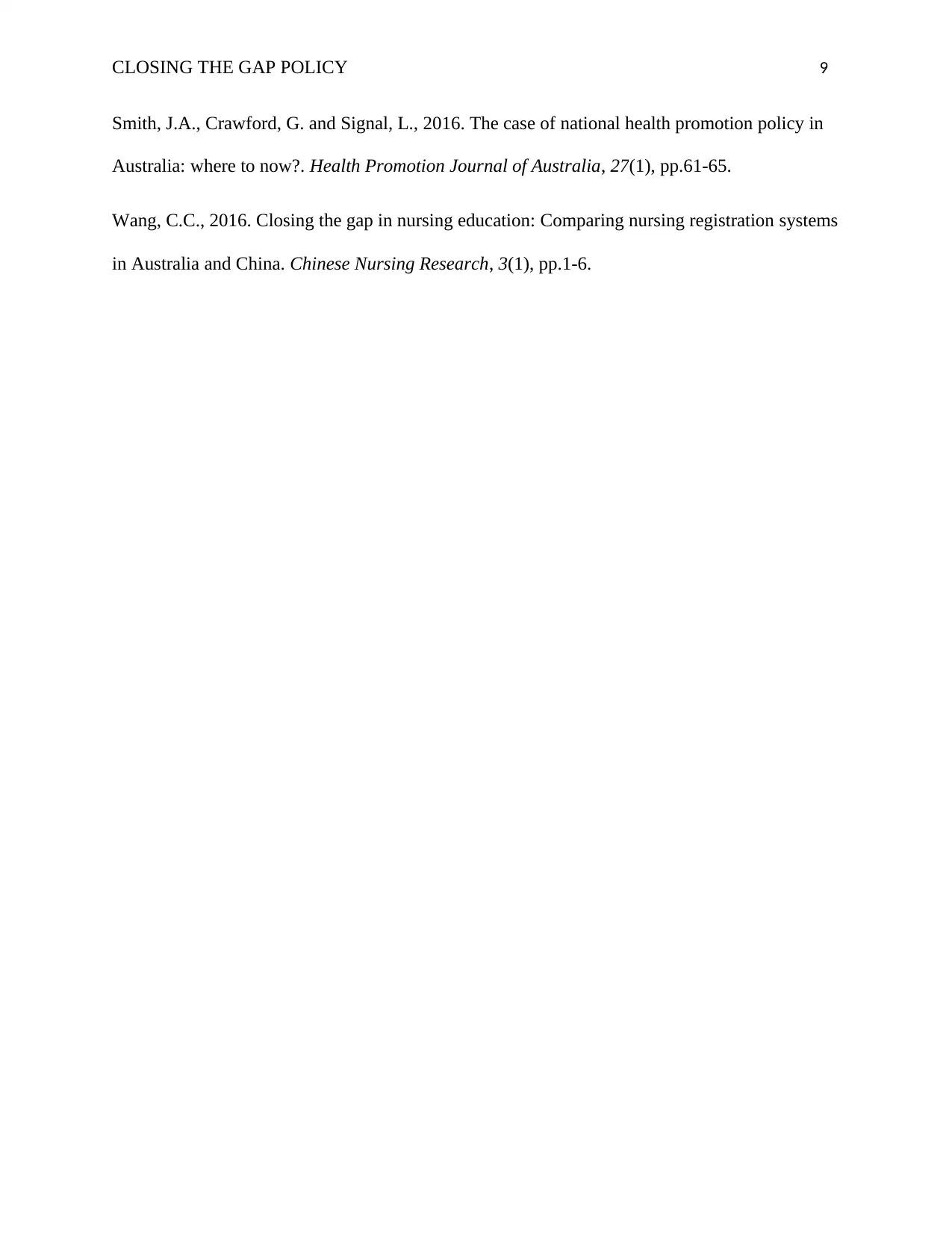
CLOSING THE GAP POLICY 9
Smith, J.A., Crawford, G. and Signal, L., 2016. The case of national health promotion policy in
Australia: where to now?. Health Promotion Journal of Australia, 27(1), pp.61-65.
Wang, C.C., 2016. Closing the gap in nursing education: Comparing nursing registration systems
in Australia and China. Chinese Nursing Research, 3(1), pp.1-6.
Smith, J.A., Crawford, G. and Signal, L., 2016. The case of national health promotion policy in
Australia: where to now?. Health Promotion Journal of Australia, 27(1), pp.61-65.
Wang, C.C., 2016. Closing the gap in nursing education: Comparing nursing registration systems
in Australia and China. Chinese Nursing Research, 3(1), pp.1-6.
⊘ This is a preview!⊘
Do you want full access?
Subscribe today to unlock all pages.

Trusted by 1+ million students worldwide
1 out of 9
Related Documents
Your All-in-One AI-Powered Toolkit for Academic Success.
+13062052269
info@desklib.com
Available 24*7 on WhatsApp / Email
![[object Object]](/_next/static/media/star-bottom.7253800d.svg)
Unlock your academic potential
Copyright © 2020–2025 A2Z Services. All Rights Reserved. Developed and managed by ZUCOL.





